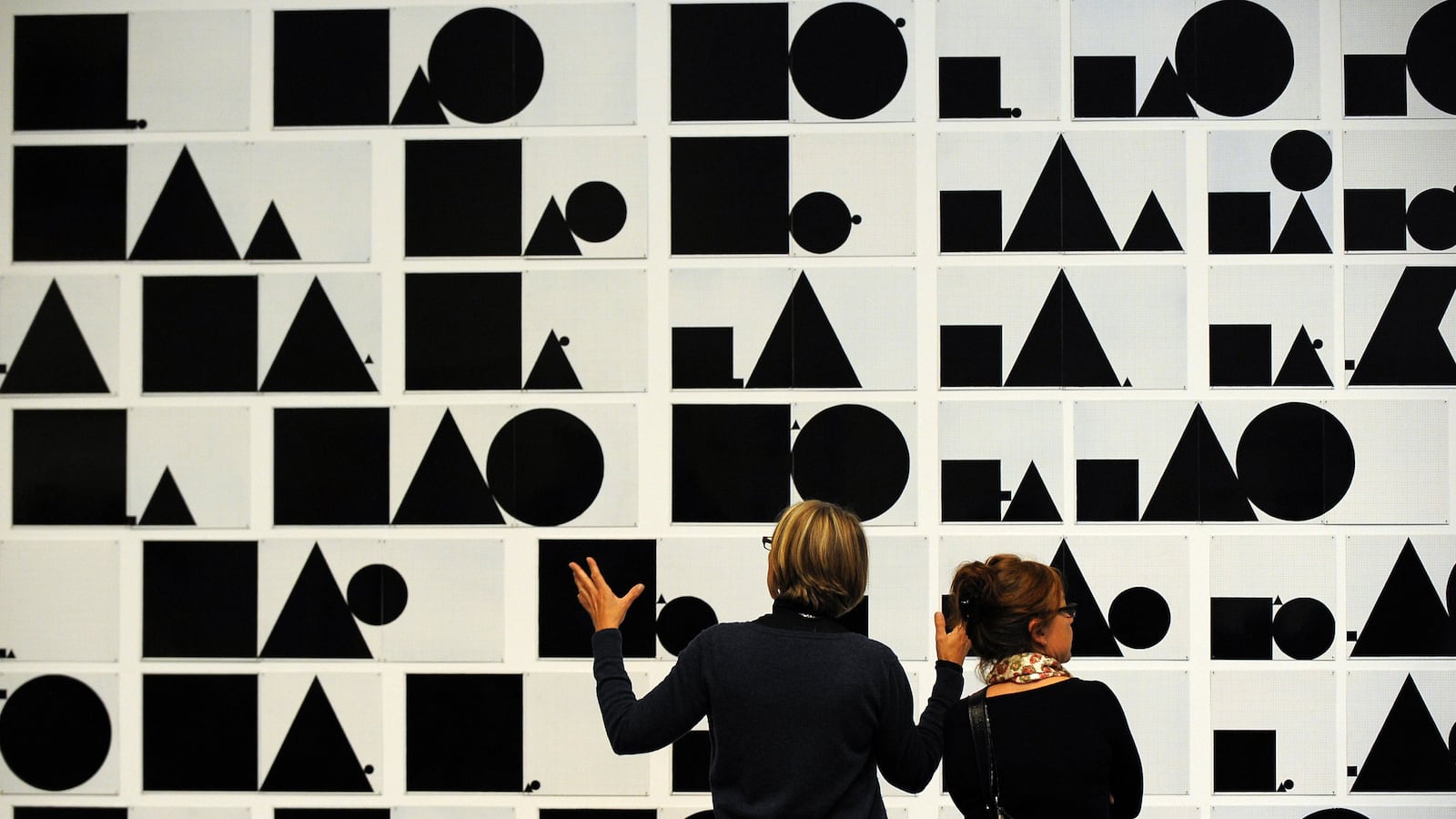Every fan of modernist design is probably familiar with a few big names.
George Nelson, the writer, designer, and popularizer largely responsible for making Herman Miller, Inc. into the modern furniture behemoth it is today.
R.M. Schindler and Richard Neutra, the trailblazing Austrian émigrés who transformed Los Angeles into a hotbed of modernist architecture.

Anni Albers, the legendary modernist textile designer. Saul Bass, the greatest designer of movie title sequences (Anatomy of a Murder, The Man with the Golden Arm) in Hollywood history. Paul Rand and Alvin Lustig, the twin titans of mid-century American graphic design. Architect Marcel Breuer. Ceramicists Gertrude and Otto Natzler. Cartoonist Saul Steinberg. Architectural photographer Julius Shulman. Industrial designer Henry Dreyfuss—the man who created the Big Ben alarm clock, the Honeywell thermostat, the Princess telephone, and the Hoover vacuum cleaner.
What every fan of modernism may not know is that all of these designers were Jewish.
A smart, handsome new exhibition at San Francisco’s Contemporary Jewish Museum called Designing Home: Jews and Midcentury Modernism seeks to remedy this oversight. It’s the first show, as the catalog puts it, to “look at the contribution of Jewish designers, architects, patrons, and merchants in the creation of a distinctly modern domestic landscape.” But Designing Home asks a deeper question as well: Why Jews? What was it about the era—and Jews in particular—that made modernism and Jewishness such a good match?
To find out more, The Daily Beast spoke to curator Donald Albrecht. He explained why Jewish émigrés equated modernism with assimilation; how Hitler helped trigger the modern movement in America; and which major American museum was responsible for making modernism seem less Jewish than it actually was.
How “overrepresented” were Jewish designers in the modern movement?
Jews do seem to have a far greater role in the movement than you would expect based solely on demographics. Just consider the ubiquity of the products: the Honeywell thermostat, the Saul Bass credit scenes. And the logos! Saul Bass, Paul Rand, and Louis Danziger. They’re in every American home.
Jews were responsible for basically every corporate logo you can imagine.
Quaker Oats, Westinghouse, IBM, ABC, UPS, Bell, Kleenex. The list goes on.

When you started researching this topic, were you surprised that Jewish designers dominated the modern design movement?
Yes. I was surprised at the extent of it. That’s why the exhibition has a quantitative capacity of sorts. I wanted to gesture at the sheer number of designers who were involved. But I also wanted to ask the questions “why?” and “how?”
My questions exactly. In the early years—the 1920s and 1930s—modernism was seen as “out there.” Avant-garde. Sort of dangerous. And Jews were at the vanguard even then. (I’m thinking of the groundbreaking Los Angeles architects R.M. Schindler and Richard Neutra.) Why?
Many of those architects and designers came from a Europe where Jews were already at the forefront of modern movements in art, in design, in music, and so on. And that’s because—especially in Europe—history has [a] very negative connotation for Jews.
History is painful.
And so historicism has a comparably negative connotation.
By historicism, you mean, like, neo-classical architecture. That sort of thing. Before modernism, designers were almost trying to recapture the past. But that was anathema to Jews.
Right. European Jews gravitated toward modernism as a way to get away from history. At the same time, though, they wanted to define themselves as sort of elite and up-and-coming. People like Siegfried Bing, who was influential in starting the Art Nouveau movement; the man who underwrote the Wiener Werkstatte in Vienna; the man who was very much behind the Deutscher Werkbund in German—they were all Jewish. It was a way to be free of historical associations and at the same time claim a new identity.
How did those desires carry over into America?
In America, anti-Semitism is less virulent and less violent. But that impulse probably came over with people like Schindler and Neutra, who emigrated from Vienna. They brought that idea with them. Then, of course, they went to Los Angeles, which in the 1920s was a city that was looking for an identity and was beginning to define itself as cutting-edge and modern.
You really have three groups of Jewish modernists. The first is the generation that came around the First World War, often because the economy in Europe was bad: Paul Frankl, Neutra, Schindler.

What’s the second?
The second is the first generation born in America: people like Julius Shulman, Paul Rand, Alex Steinweiss, and Alvin Lustig. Unlike other groups, Jewish émigrés didn’t want to go back—for obvious reasons. They planned to stay. And so, more than other immigrant groups, they and their children adopted American ways. In the post-World War II period, that meant “going modern.” As the architect Eric Mendelsohn put it, Jews wanted to be part of the American mainstream—and that mainstream was modern.
There was almost an increased sensitivity to what was American and a greater desire to participate in being American. Assimilation was more urgent that it may have been for other immigrants.
Absolutely.
And what about the third group?
The third group came in the 1930s because of Adolf Hitler: Anni Albers, Ruth Adler Schnee, Marcel Breuer. Hitler was profoundly anti-Semitic, but he was also anti-Modern. So you had a large contingent of émigrés from the Bauhaus, and they were very much embraced by places like the Museum of Modern Art. That exodus greatly increased the number of modern Jewish designers and architects in America.
Then these three groups merged after World War II, and that’s what gave the period its richness: the American Jews and the European émigrés coming together. That was mid-century modernism.
A lot of doors were closed to Jews in the first half of the 20th century. How did they suddenly become so prominent in the modernist design movement?
There were several organizations, like the Walker Art Center in Minneapolis, that defined themselves as modern by not being anti-Semitic—by being open to Europeans and Americans, Jews and Gentiles. It was through these organizations that Jewish designers entered the mainstream of American design and American life. Meanwhile, the Bauhaus teaching method—the workshop system—started cropping up all over America: at Black Mountain College in North Carolina, where Josef and Anni Albers went to teach; at the Institute of Design in Chicago, with Laszlo Moholy-Nagy; and at Pond Farm, north of San Francisco. The first three faculty members at Pond Farm were all Jewish émigrés from Nazi Germany.
It was like a perfect storm.
That’s exactly what it was.
You had Jewish designers who were suddenly getting opportunities they may not have gotten before, in large part because being modern meant overcoming the anti-Semitism that had triggered World War II. Meanwhile, the larger culture was starting to accept modernism because there were these big institutions promoting it.
Right. Obviously the whole middle class didn’t go modern. But there was certainly a flourishing of it right after World War II.
What about Jewish consumers? Were they more interested in modernism than the American public at large?
Many were.
Why?
It was modern, it was new, it was free of the Old World. “We’re here in America, we’re going to be modern.”

In the early years, modernism had a kind of progressive, even socialist bent to it. Schindler’s house in L.A. is all about communal living. The architect Gregory Ain was very interested in planned communities. Was there anything about the ideology of modernism—the egalitarianism, the communitarianism—that resonated with Jews in particular?
Yes. Definitely in the early adopters. I’m reminded of a quote from the Jewish architect Percival Goodman. He wrote in 1961 that modernism was especially suited to “people historically conditioned like the Jews” to embrace social reform and community spirit.
But that’s not how we think of modernism today, is it? We picture Don Draper and Mad Men.
In America, modernism was stripped of its socialist leanings. It became more of a symbol of the capitalist good life.
How?
The Museum of Modern Art was largely responsible for this. In the 1930s, MoMA did a big show on the Bauhaus, and they worked very hard to say that modernism was a style. That it wasn’t a political or religious symbol. There are very interesting letters between Walter Gropius, head of the Bauhaus, and Alfred Barr, the first director of MoMA. They wrote back and forth about this issue. “We don’t want people to think modernism is communist.”
That was a big question at the time, wasn’t it? There were Americans who disparaged modernism because it was European and “socialist.”
There were. And I would argue, for better or for worse, that by the late 1930s those political overtones had been scrubbed away in the American context. Instead modernism became a style that was acceptable for “forward-thinking people”—not for communists, or socialists, or whatever.
Was modernism also stigmatized for being a “Jewish thing?”
Yes. That was what was behind those letters between Gropius and Barr. Barr wrote to Gropius and said, “Well, as you can imagine, the show is being called Jewish. A lot of people don’t even know that some of these names aren’t Jewish. But they’re assuming it’s all a kind of Communist-Jewish cabal.” The year was 1938. That sort of thing was in the air.
And so MoMA was able to rebrand modernism.
They were very active in doing that, in part because their trustees were very wealthy capitalists. The Rockefellers were not going to underwrite a museum that promoted communism. It was a simple as that. If modernism was going to be acceptable, its leftist leanings had to be gotten rid of.
And so the Jewishness of modernism was written out of the history in a way. It was deemphasized.
By writing out the leftism, they wrote out the Jewishness. But the Jewishness has always been a big part of the story.
This interview has been edited and condensed.






